Information Systems and Big Data Analysis for TESCO
VerifiedAdded on 2023/06/14
|8
|2981
|221
AI Summary
This report discusses the design and development of IT solutions like McAfee and Moodle, globalization and its effects on IT, advantages and disadvantages of digital infrastructure, and risks associated with information systems outsourcing for TESCO.
Contribute Materials
Your contribution can guide someone’s learning journey. Share your
documents today.
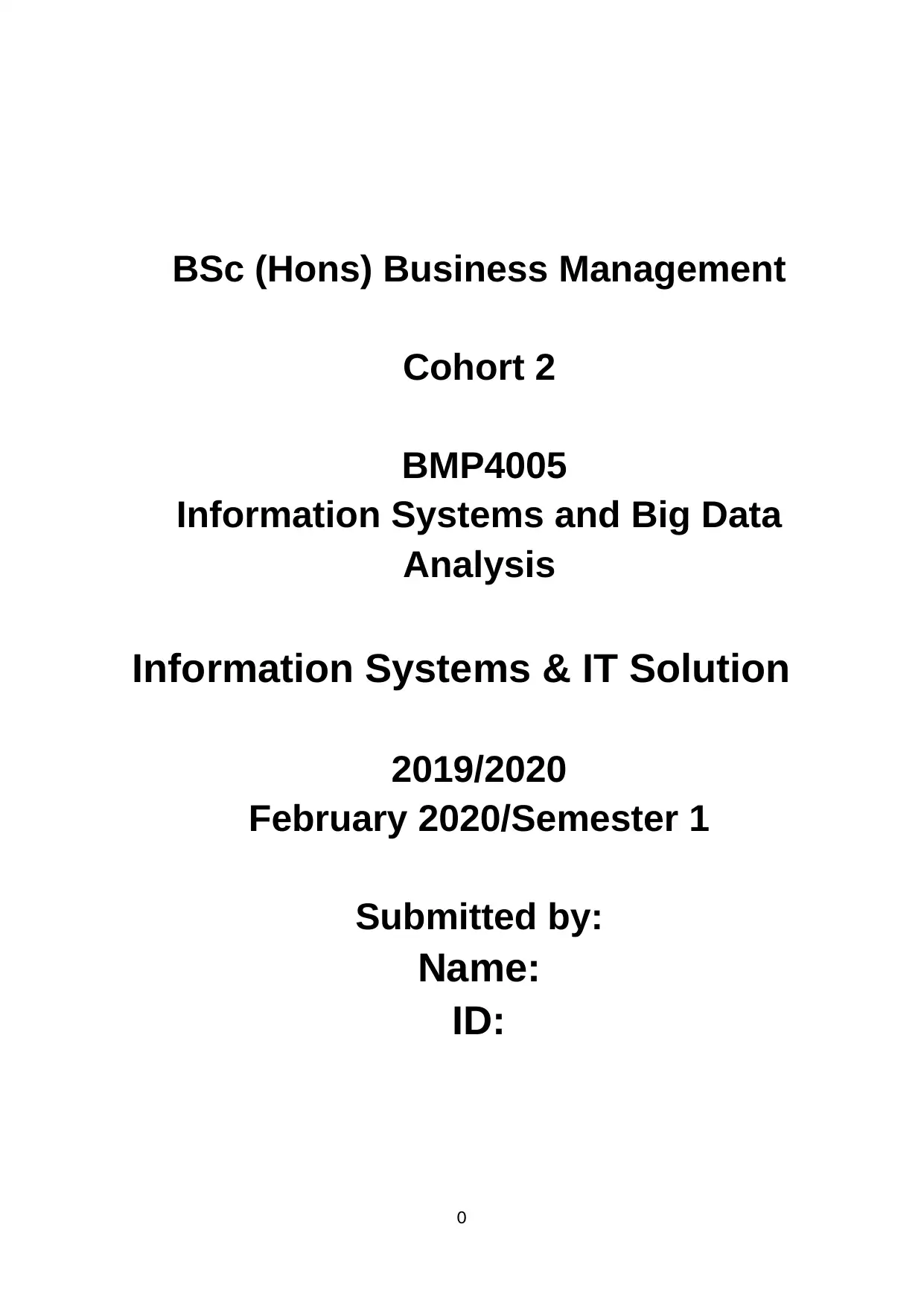
BSc (Hons) Business Management
Cohort 2
BMP4005
Information Systems and Big Data
Analysis
Information Systems & IT Solution
2019/2020
February 2020/Semester 1
Submitted by:
Name:
ID:
0
Cohort 2
BMP4005
Information Systems and Big Data
Analysis
Information Systems & IT Solution
2019/2020
February 2020/Semester 1
Submitted by:
Name:
ID:
0
Secure Best Marks with AI Grader
Need help grading? Try our AI Grader for instant feedback on your assignments.
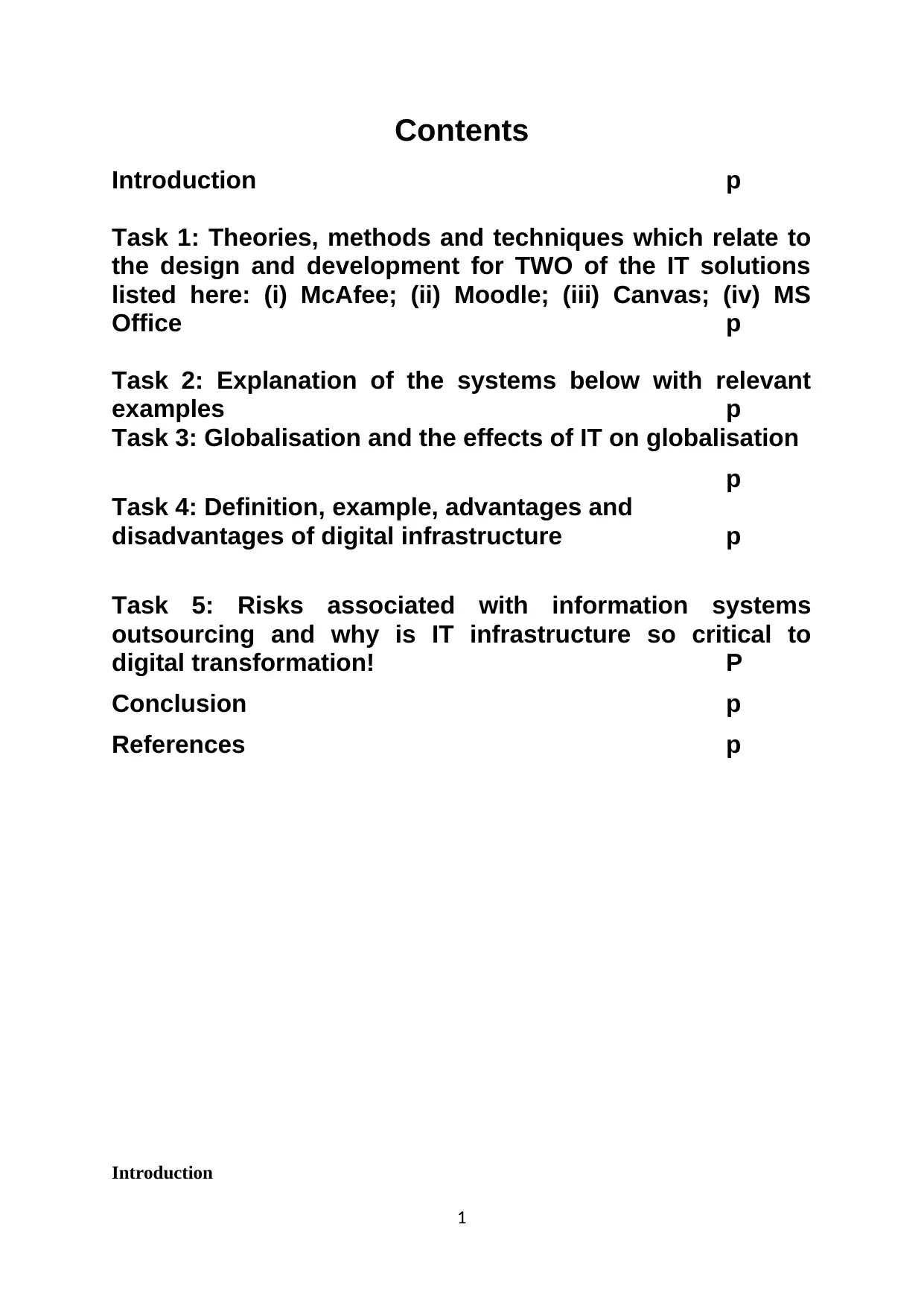
Contents
Introduction p
Task 1: Theories, methods and techniques which relate to
the design and development for TWO of the IT solutions
listed here: (i) McAfee; (ii) Moodle; (iii) Canvas; (iv) MS
Office p
Task 2: Explanation of the systems below with relevant
examples p
Task 3: Globalisation and the effects of IT on globalisation
p
Task 4: Definition, example, advantages and
disadvantages of digital infrastructure p
Task 5: Risks associated with information systems
outsourcing and why is IT infrastructure so critical to
digital transformation! P
Conclusion p
References p
Introduction
1
Introduction p
Task 1: Theories, methods and techniques which relate to
the design and development for TWO of the IT solutions
listed here: (i) McAfee; (ii) Moodle; (iii) Canvas; (iv) MS
Office p
Task 2: Explanation of the systems below with relevant
examples p
Task 3: Globalisation and the effects of IT on globalisation
p
Task 4: Definition, example, advantages and
disadvantages of digital infrastructure p
Task 5: Risks associated with information systems
outsourcing and why is IT infrastructure so critical to
digital transformation! P
Conclusion p
References p
Introduction
1
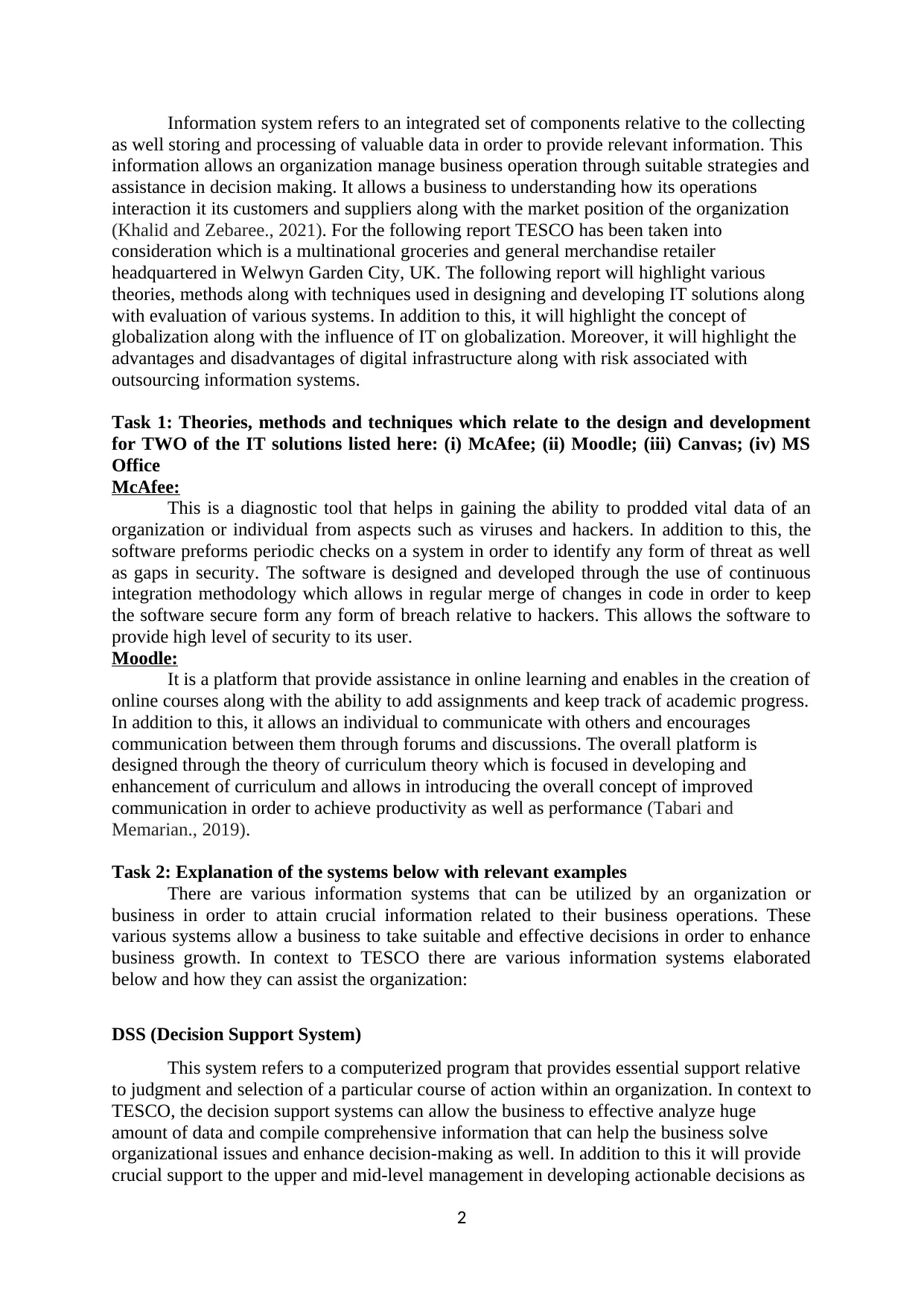
Information system refers to an integrated set of components relative to the collecting
as well storing and processing of valuable data in order to provide relevant information. This
information allows an organization manage business operation through suitable strategies and
assistance in decision making. It allows a business to understanding how its operations
interaction it its customers and suppliers along with the market position of the organization
(Khalid and Zebaree., 2021). For the following report TESCO has been taken into
consideration which is a multinational groceries and general merchandise retailer
headquartered in Welwyn Garden City, UK. The following report will highlight various
theories, methods along with techniques used in designing and developing IT solutions along
with evaluation of various systems. In addition to this, it will highlight the concept of
globalization along with the influence of IT on globalization. Moreover, it will highlight the
advantages and disadvantages of digital infrastructure along with risk associated with
outsourcing information systems.
Task 1: Theories, methods and techniques which relate to the design and development
for TWO of the IT solutions listed here: (i) McAfee; (ii) Moodle; (iii) Canvas; (iv) MS
Office
McAfee:
This is a diagnostic tool that helps in gaining the ability to prodded vital data of an
organization or individual from aspects such as viruses and hackers. In addition to this, the
software preforms periodic checks on a system in order to identify any form of threat as well
as gaps in security. The software is designed and developed through the use of continuous
integration methodology which allows in regular merge of changes in code in order to keep
the software secure form any form of breach relative to hackers. This allows the software to
provide high level of security to its user.
Moodle:
It is a platform that provide assistance in online learning and enables in the creation of
online courses along with the ability to add assignments and keep track of academic progress.
In addition to this, it allows an individual to communicate with others and encourages
communication between them through forums and discussions. The overall platform is
designed through the theory of curriculum theory which is focused in developing and
enhancement of curriculum and allows in introducing the overall concept of improved
communication in order to achieve productivity as well as performance (Tabari and
Memarian., 2019).
Task 2: Explanation of the systems below with relevant examples
There are various information systems that can be utilized by an organization or
business in order to attain crucial information related to their business operations. These
various systems allow a business to take suitable and effective decisions in order to enhance
business growth. In context to TESCO there are various information systems elaborated
below and how they can assist the organization:
DSS (Decision Support System)
This system refers to a computerized program that provides essential support relative
to judgment and selection of a particular course of action within an organization. In context to
TESCO, the decision support systems can allow the business to effective analyze huge
amount of data and compile comprehensive information that can help the business solve
organizational issues and enhance decision-making as well. In addition to this it will provide
crucial support to the upper and mid-level management in developing actionable decisions as
2
as well storing and processing of valuable data in order to provide relevant information. This
information allows an organization manage business operation through suitable strategies and
assistance in decision making. It allows a business to understanding how its operations
interaction it its customers and suppliers along with the market position of the organization
(Khalid and Zebaree., 2021). For the following report TESCO has been taken into
consideration which is a multinational groceries and general merchandise retailer
headquartered in Welwyn Garden City, UK. The following report will highlight various
theories, methods along with techniques used in designing and developing IT solutions along
with evaluation of various systems. In addition to this, it will highlight the concept of
globalization along with the influence of IT on globalization. Moreover, it will highlight the
advantages and disadvantages of digital infrastructure along with risk associated with
outsourcing information systems.
Task 1: Theories, methods and techniques which relate to the design and development
for TWO of the IT solutions listed here: (i) McAfee; (ii) Moodle; (iii) Canvas; (iv) MS
Office
McAfee:
This is a diagnostic tool that helps in gaining the ability to prodded vital data of an
organization or individual from aspects such as viruses and hackers. In addition to this, the
software preforms periodic checks on a system in order to identify any form of threat as well
as gaps in security. The software is designed and developed through the use of continuous
integration methodology which allows in regular merge of changes in code in order to keep
the software secure form any form of breach relative to hackers. This allows the software to
provide high level of security to its user.
Moodle:
It is a platform that provide assistance in online learning and enables in the creation of
online courses along with the ability to add assignments and keep track of academic progress.
In addition to this, it allows an individual to communicate with others and encourages
communication between them through forums and discussions. The overall platform is
designed through the theory of curriculum theory which is focused in developing and
enhancement of curriculum and allows in introducing the overall concept of improved
communication in order to achieve productivity as well as performance (Tabari and
Memarian., 2019).
Task 2: Explanation of the systems below with relevant examples
There are various information systems that can be utilized by an organization or
business in order to attain crucial information related to their business operations. These
various systems allow a business to take suitable and effective decisions in order to enhance
business growth. In context to TESCO there are various information systems elaborated
below and how they can assist the organization:
DSS (Decision Support System)
This system refers to a computerized program that provides essential support relative
to judgment and selection of a particular course of action within an organization. In context to
TESCO, the decision support systems can allow the business to effective analyze huge
amount of data and compile comprehensive information that can help the business solve
organizational issues and enhance decision-making as well. In addition to this it will provide
crucial support to the upper and mid-level management in developing actionable decisions as
2
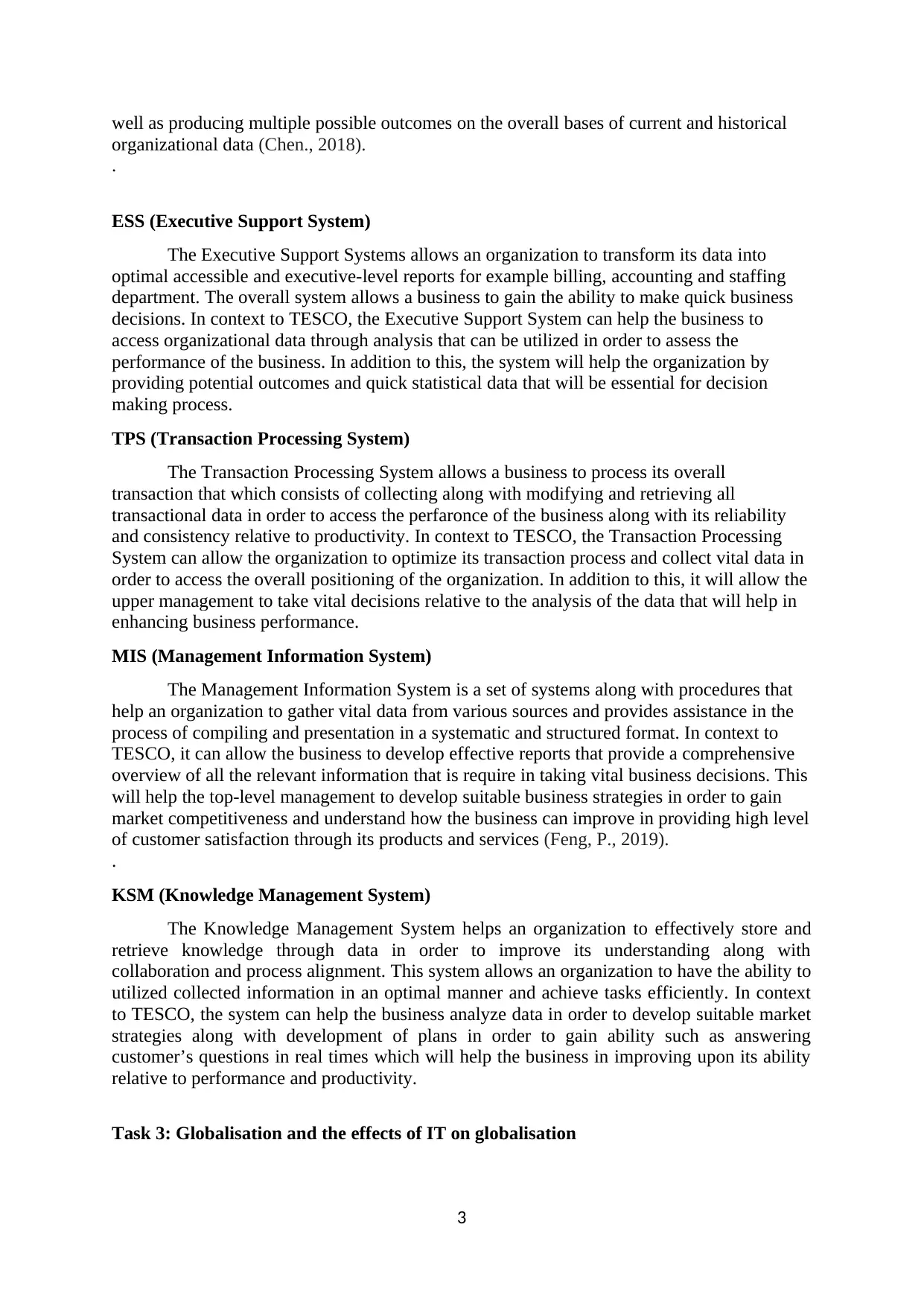
well as producing multiple possible outcomes on the overall bases of current and historical
organizational data (Chen., 2018).
.
ESS (Executive Support System)
The Executive Support Systems allows an organization to transform its data into
optimal accessible and executive-level reports for example billing, accounting and staffing
department. The overall system allows a business to gain the ability to make quick business
decisions. In context to TESCO, the Executive Support System can help the business to
access organizational data through analysis that can be utilized in order to assess the
performance of the business. In addition to this, the system will help the organization by
providing potential outcomes and quick statistical data that will be essential for decision
making process.
TPS (Transaction Processing System)
The Transaction Processing System allows a business to process its overall
transaction that which consists of collecting along with modifying and retrieving all
transactional data in order to access the perfaronce of the business along with its reliability
and consistency relative to productivity. In context to TESCO, the Transaction Processing
System can allow the organization to optimize its transaction process and collect vital data in
order to access the overall positioning of the organization. In addition to this, it will allow the
upper management to take vital decisions relative to the analysis of the data that will help in
enhancing business performance.
MIS (Management Information System)
The Management Information System is a set of systems along with procedures that
help an organization to gather vital data from various sources and provides assistance in the
process of compiling and presentation in a systematic and structured format. In context to
TESCO, it can allow the business to develop effective reports that provide a comprehensive
overview of all the relevant information that is require in taking vital business decisions. This
will help the top-level management to develop suitable business strategies in order to gain
market competitiveness and understand how the business can improve in providing high level
of customer satisfaction through its products and services (Feng, P., 2019).
.
KSM (Knowledge Management System)
The Knowledge Management System helps an organization to effectively store and
retrieve knowledge through data in order to improve its understanding along with
collaboration and process alignment. This system allows an organization to have the ability to
utilized collected information in an optimal manner and achieve tasks efficiently. In context
to TESCO, the system can help the business analyze data in order to develop suitable market
strategies along with development of plans in order to gain ability such as answering
customer’s questions in real times which will help the business in improving upon its ability
relative to performance and productivity.
Task 3: Globalisation and the effects of IT on globalisation
3
organizational data (Chen., 2018).
.
ESS (Executive Support System)
The Executive Support Systems allows an organization to transform its data into
optimal accessible and executive-level reports for example billing, accounting and staffing
department. The overall system allows a business to gain the ability to make quick business
decisions. In context to TESCO, the Executive Support System can help the business to
access organizational data through analysis that can be utilized in order to assess the
performance of the business. In addition to this, the system will help the organization by
providing potential outcomes and quick statistical data that will be essential for decision
making process.
TPS (Transaction Processing System)
The Transaction Processing System allows a business to process its overall
transaction that which consists of collecting along with modifying and retrieving all
transactional data in order to access the perfaronce of the business along with its reliability
and consistency relative to productivity. In context to TESCO, the Transaction Processing
System can allow the organization to optimize its transaction process and collect vital data in
order to access the overall positioning of the organization. In addition to this, it will allow the
upper management to take vital decisions relative to the analysis of the data that will help in
enhancing business performance.
MIS (Management Information System)
The Management Information System is a set of systems along with procedures that
help an organization to gather vital data from various sources and provides assistance in the
process of compiling and presentation in a systematic and structured format. In context to
TESCO, it can allow the business to develop effective reports that provide a comprehensive
overview of all the relevant information that is require in taking vital business decisions. This
will help the top-level management to develop suitable business strategies in order to gain
market competitiveness and understand how the business can improve in providing high level
of customer satisfaction through its products and services (Feng, P., 2019).
.
KSM (Knowledge Management System)
The Knowledge Management System helps an organization to effectively store and
retrieve knowledge through data in order to improve its understanding along with
collaboration and process alignment. This system allows an organization to have the ability to
utilized collected information in an optimal manner and achieve tasks efficiently. In context
to TESCO, the system can help the business analyze data in order to develop suitable market
strategies along with development of plans in order to gain ability such as answering
customer’s questions in real times which will help the business in improving upon its ability
relative to performance and productivity.
Task 3: Globalisation and the effects of IT on globalisation
3
Secure Best Marks with AI Grader
Need help grading? Try our AI Grader for instant feedback on your assignments.
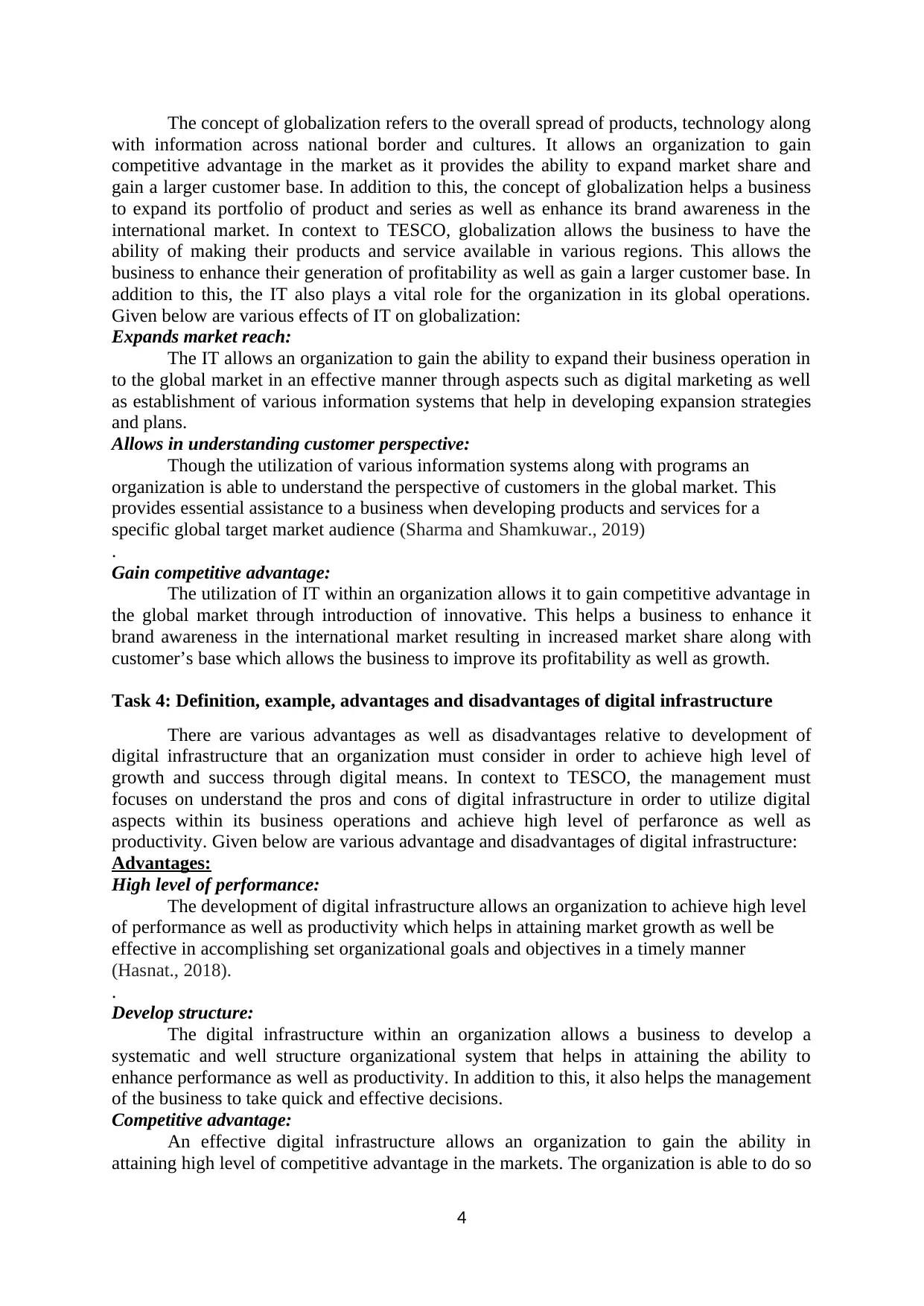
The concept of globalization refers to the overall spread of products, technology along
with information across national border and cultures. It allows an organization to gain
competitive advantage in the market as it provides the ability to expand market share and
gain a larger customer base. In addition to this, the concept of globalization helps a business
to expand its portfolio of product and series as well as enhance its brand awareness in the
international market. In context to TESCO, globalization allows the business to have the
ability of making their products and service available in various regions. This allows the
business to enhance their generation of profitability as well as gain a larger customer base. In
addition to this, the IT also plays a vital role for the organization in its global operations.
Given below are various effects of IT on globalization:
Expands market reach:
The IT allows an organization to gain the ability to expand their business operation in
to the global market in an effective manner through aspects such as digital marketing as well
as establishment of various information systems that help in developing expansion strategies
and plans.
Allows in understanding customer perspective:
Though the utilization of various information systems along with programs an
organization is able to understand the perspective of customers in the global market. This
provides essential assistance to a business when developing products and services for a
specific global target market audience (Sharma and Shamkuwar., 2019)
.
Gain competitive advantage:
The utilization of IT within an organization allows it to gain competitive advantage in
the global market through introduction of innovative. This helps a business to enhance it
brand awareness in the international market resulting in increased market share along with
customer’s base which allows the business to improve its profitability as well as growth.
Task 4: Definition, example, advantages and disadvantages of digital infrastructure
There are various advantages as well as disadvantages relative to development of
digital infrastructure that an organization must consider in order to achieve high level of
growth and success through digital means. In context to TESCO, the management must
focuses on understand the pros and cons of digital infrastructure in order to utilize digital
aspects within its business operations and achieve high level of perfaronce as well as
productivity. Given below are various advantage and disadvantages of digital infrastructure:
Advantages:
High level of performance:
The development of digital infrastructure allows an organization to achieve high level
of performance as well as productivity which helps in attaining market growth as well be
effective in accomplishing set organizational goals and objectives in a timely manner
(Hasnat., 2018).
.
Develop structure:
The digital infrastructure within an organization allows a business to develop a
systematic and well structure organizational system that helps in attaining the ability to
enhance performance as well as productivity. In addition to this, it also helps the management
of the business to take quick and effective decisions.
Competitive advantage:
An effective digital infrastructure allows an organization to gain the ability in
attaining high level of competitive advantage in the markets. The organization is able to do so
4
with information across national border and cultures. It allows an organization to gain
competitive advantage in the market as it provides the ability to expand market share and
gain a larger customer base. In addition to this, the concept of globalization helps a business
to expand its portfolio of product and series as well as enhance its brand awareness in the
international market. In context to TESCO, globalization allows the business to have the
ability of making their products and service available in various regions. This allows the
business to enhance their generation of profitability as well as gain a larger customer base. In
addition to this, the IT also plays a vital role for the organization in its global operations.
Given below are various effects of IT on globalization:
Expands market reach:
The IT allows an organization to gain the ability to expand their business operation in
to the global market in an effective manner through aspects such as digital marketing as well
as establishment of various information systems that help in developing expansion strategies
and plans.
Allows in understanding customer perspective:
Though the utilization of various information systems along with programs an
organization is able to understand the perspective of customers in the global market. This
provides essential assistance to a business when developing products and services for a
specific global target market audience (Sharma and Shamkuwar., 2019)
.
Gain competitive advantage:
The utilization of IT within an organization allows it to gain competitive advantage in
the global market through introduction of innovative. This helps a business to enhance it
brand awareness in the international market resulting in increased market share along with
customer’s base which allows the business to improve its profitability as well as growth.
Task 4: Definition, example, advantages and disadvantages of digital infrastructure
There are various advantages as well as disadvantages relative to development of
digital infrastructure that an organization must consider in order to achieve high level of
growth and success through digital means. In context to TESCO, the management must
focuses on understand the pros and cons of digital infrastructure in order to utilize digital
aspects within its business operations and achieve high level of perfaronce as well as
productivity. Given below are various advantage and disadvantages of digital infrastructure:
Advantages:
High level of performance:
The development of digital infrastructure allows an organization to achieve high level
of performance as well as productivity which helps in attaining market growth as well be
effective in accomplishing set organizational goals and objectives in a timely manner
(Hasnat., 2018).
.
Develop structure:
The digital infrastructure within an organization allows a business to develop a
systematic and well structure organizational system that helps in attaining the ability to
enhance performance as well as productivity. In addition to this, it also helps the management
of the business to take quick and effective decisions.
Competitive advantage:
An effective digital infrastructure allows an organization to gain the ability in
attaining high level of competitive advantage in the markets. The organization is able to do so
4
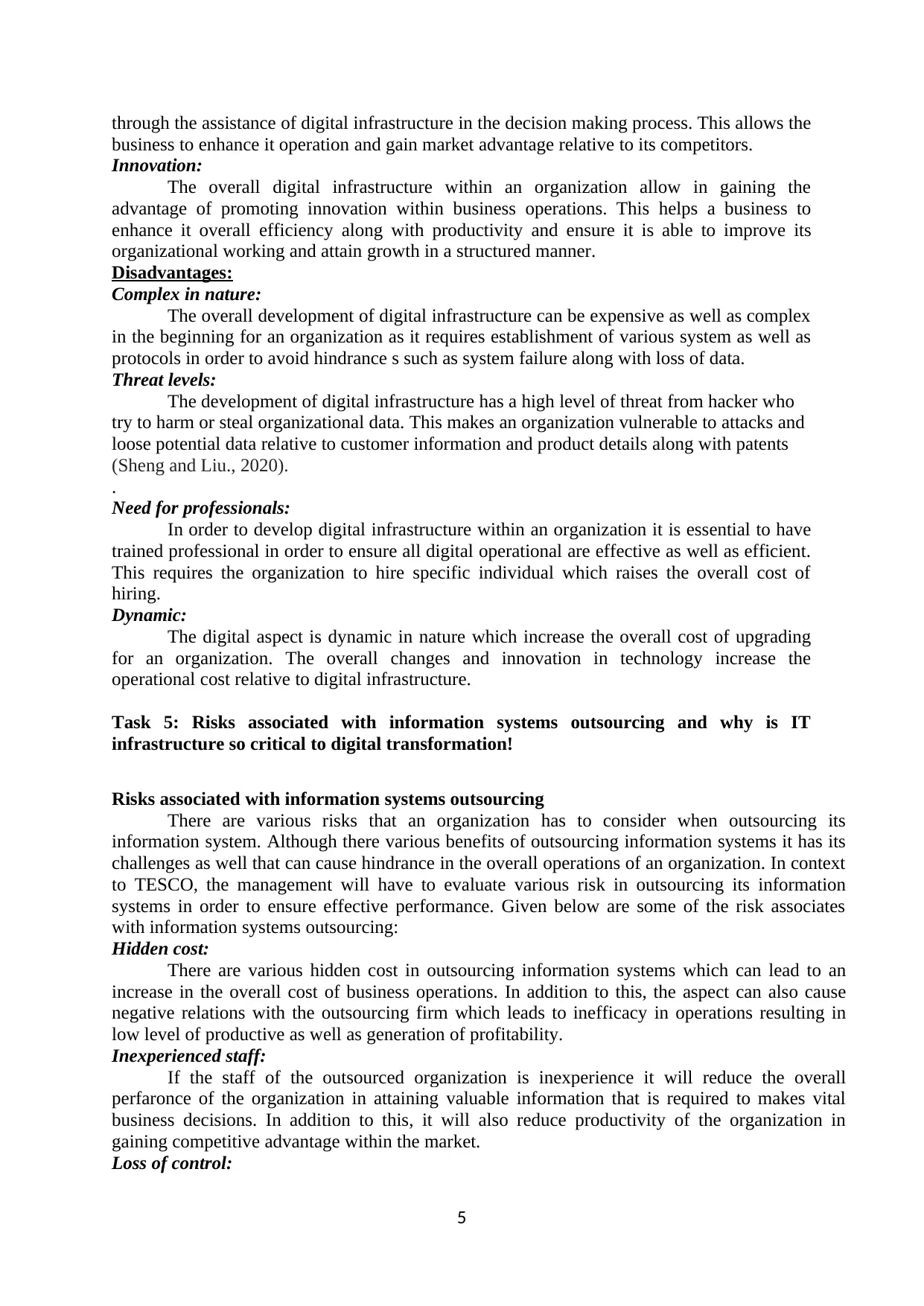
through the assistance of digital infrastructure in the decision making process. This allows the
business to enhance it operation and gain market advantage relative to its competitors.
Innovation:
The overall digital infrastructure within an organization allow in gaining the
advantage of promoting innovation within business operations. This helps a business to
enhance it overall efficiency along with productivity and ensure it is able to improve its
organizational working and attain growth in a structured manner.
Disadvantages:
Complex in nature:
The overall development of digital infrastructure can be expensive as well as complex
in the beginning for an organization as it requires establishment of various system as well as
protocols in order to avoid hindrance s such as system failure along with loss of data.
Threat levels:
The development of digital infrastructure has a high level of threat from hacker who
try to harm or steal organizational data. This makes an organization vulnerable to attacks and
loose potential data relative to customer information and product details along with patents
(Sheng and Liu., 2020).
.
Need for professionals:
In order to develop digital infrastructure within an organization it is essential to have
trained professional in order to ensure all digital operational are effective as well as efficient.
This requires the organization to hire specific individual which raises the overall cost of
hiring.
Dynamic:
The digital aspect is dynamic in nature which increase the overall cost of upgrading
for an organization. The overall changes and innovation in technology increase the
operational cost relative to digital infrastructure.
Task 5: Risks associated with information systems outsourcing and why is IT
infrastructure so critical to digital transformation!
Risks associated with information systems outsourcing
There are various risks that an organization has to consider when outsourcing its
information system. Although there various benefits of outsourcing information systems it has its
challenges as well that can cause hindrance in the overall operations of an organization. In context
to TESCO, the management will have to evaluate various risk in outsourcing its information
systems in order to ensure effective performance. Given below are some of the risk associates
with information systems outsourcing:
Hidden cost:
There are various hidden cost in outsourcing information systems which can lead to an
increase in the overall cost of business operations. In addition to this, the aspect can also cause
negative relations with the outsourcing firm which leads to inefficacy in operations resulting in
low level of productive as well as generation of profitability.
Inexperienced staff:
If the staff of the outsourced organization is inexperience it will reduce the overall
perfaronce of the organization in attaining valuable information that is required to makes vital
business decisions. In addition to this, it will also reduce productivity of the organization in
gaining competitive advantage within the market.
Loss of control:
5
business to enhance it operation and gain market advantage relative to its competitors.
Innovation:
The overall digital infrastructure within an organization allow in gaining the
advantage of promoting innovation within business operations. This helps a business to
enhance it overall efficiency along with productivity and ensure it is able to improve its
organizational working and attain growth in a structured manner.
Disadvantages:
Complex in nature:
The overall development of digital infrastructure can be expensive as well as complex
in the beginning for an organization as it requires establishment of various system as well as
protocols in order to avoid hindrance s such as system failure along with loss of data.
Threat levels:
The development of digital infrastructure has a high level of threat from hacker who
try to harm or steal organizational data. This makes an organization vulnerable to attacks and
loose potential data relative to customer information and product details along with patents
(Sheng and Liu., 2020).
.
Need for professionals:
In order to develop digital infrastructure within an organization it is essential to have
trained professional in order to ensure all digital operational are effective as well as efficient.
This requires the organization to hire specific individual which raises the overall cost of
hiring.
Dynamic:
The digital aspect is dynamic in nature which increase the overall cost of upgrading
for an organization. The overall changes and innovation in technology increase the
operational cost relative to digital infrastructure.
Task 5: Risks associated with information systems outsourcing and why is IT
infrastructure so critical to digital transformation!
Risks associated with information systems outsourcing
There are various risks that an organization has to consider when outsourcing its
information system. Although there various benefits of outsourcing information systems it has its
challenges as well that can cause hindrance in the overall operations of an organization. In context
to TESCO, the management will have to evaluate various risk in outsourcing its information
systems in order to ensure effective performance. Given below are some of the risk associates
with information systems outsourcing:
Hidden cost:
There are various hidden cost in outsourcing information systems which can lead to an
increase in the overall cost of business operations. In addition to this, the aspect can also cause
negative relations with the outsourcing firm which leads to inefficacy in operations resulting in
low level of productive as well as generation of profitability.
Inexperienced staff:
If the staff of the outsourced organization is inexperience it will reduce the overall
perfaronce of the organization in attaining valuable information that is required to makes vital
business decisions. In addition to this, it will also reduce productivity of the organization in
gaining competitive advantage within the market.
Loss of control:
5
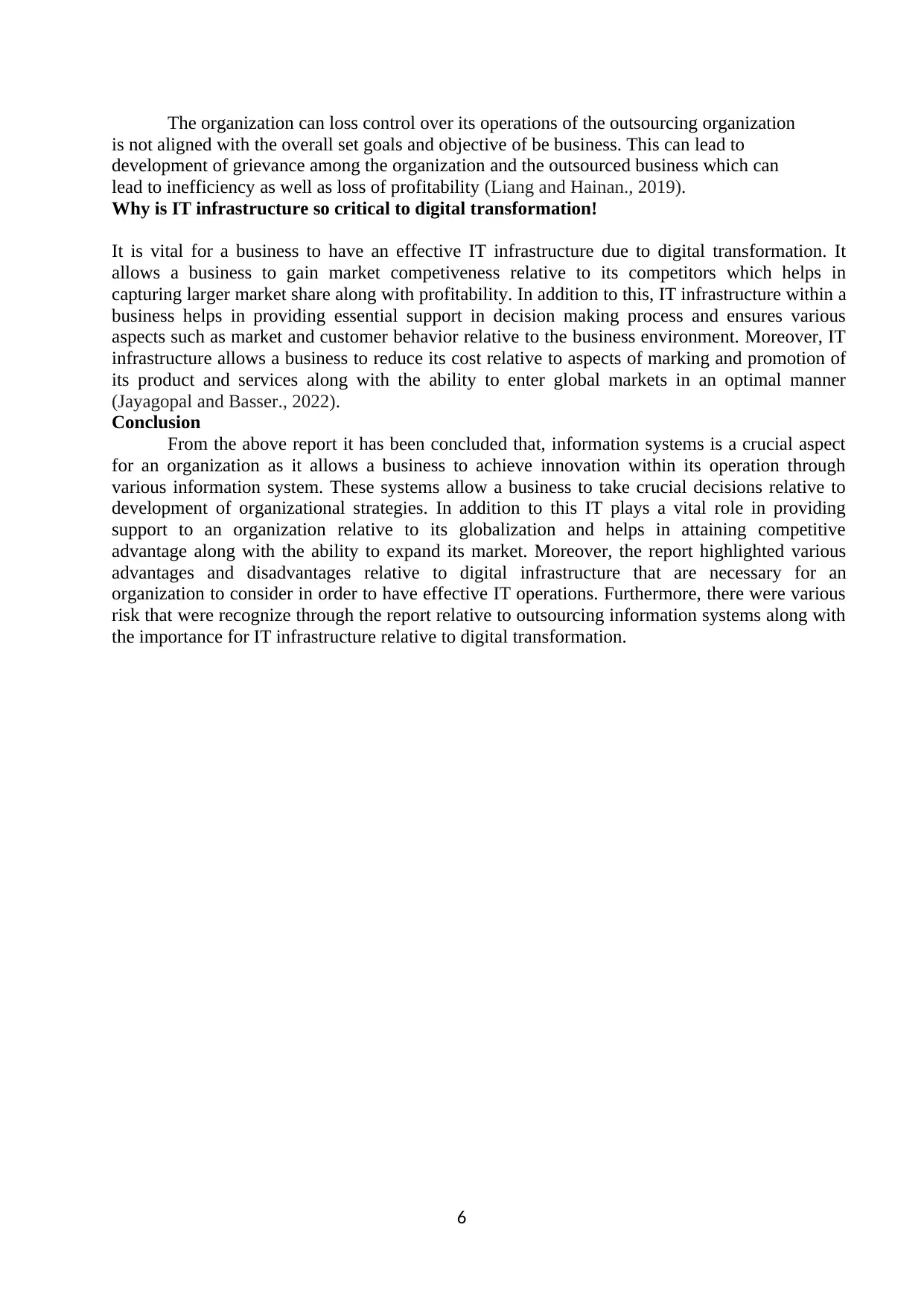
The organization can loss control over its operations of the outsourcing organization
is not aligned with the overall set goals and objective of be business. This can lead to
development of grievance among the organization and the outsourced business which can
lead to inefficiency as well as loss of profitability (Liang and Hainan., 2019).
Why is IT infrastructure so critical to digital transformation!
It is vital for a business to have an effective IT infrastructure due to digital transformation. It
allows a business to gain market competiveness relative to its competitors which helps in
capturing larger market share along with profitability. In addition to this, IT infrastructure within a
business helps in providing essential support in decision making process and ensures various
aspects such as market and customer behavior relative to the business environment. Moreover, IT
infrastructure allows a business to reduce its cost relative to aspects of marking and promotion of
its product and services along with the ability to enter global markets in an optimal manner
(Jayagopal and Basser., 2022).
Conclusion
From the above report it has been concluded that, information systems is a crucial aspect
for an organization as it allows a business to achieve innovation within its operation through
various information system. These systems allow a business to take crucial decisions relative to
development of organizational strategies. In addition to this IT plays a vital role in providing
support to an organization relative to its globalization and helps in attaining competitive
advantage along with the ability to expand its market. Moreover, the report highlighted various
advantages and disadvantages relative to digital infrastructure that are necessary for an
organization to consider in order to have effective IT operations. Furthermore, there were various
risk that were recognize through the report relative to outsourcing information systems along with
the importance for IT infrastructure relative to digital transformation.
6
is not aligned with the overall set goals and objective of be business. This can lead to
development of grievance among the organization and the outsourced business which can
lead to inefficiency as well as loss of profitability (Liang and Hainan., 2019).
Why is IT infrastructure so critical to digital transformation!
It is vital for a business to have an effective IT infrastructure due to digital transformation. It
allows a business to gain market competiveness relative to its competitors which helps in
capturing larger market share along with profitability. In addition to this, IT infrastructure within a
business helps in providing essential support in decision making process and ensures various
aspects such as market and customer behavior relative to the business environment. Moreover, IT
infrastructure allows a business to reduce its cost relative to aspects of marking and promotion of
its product and services along with the ability to enter global markets in an optimal manner
(Jayagopal and Basser., 2022).
Conclusion
From the above report it has been concluded that, information systems is a crucial aspect
for an organization as it allows a business to achieve innovation within its operation through
various information system. These systems allow a business to take crucial decisions relative to
development of organizational strategies. In addition to this IT plays a vital role in providing
support to an organization relative to its globalization and helps in attaining competitive
advantage along with the ability to expand its market. Moreover, the report highlighted various
advantages and disadvantages relative to digital infrastructure that are necessary for an
organization to consider in order to have effective IT operations. Furthermore, there were various
risk that were recognize through the report relative to outsourcing information systems along with
the importance for IT infrastructure relative to digital transformation.
6
Paraphrase This Document
Need a fresh take? Get an instant paraphrase of this document with our AI Paraphraser
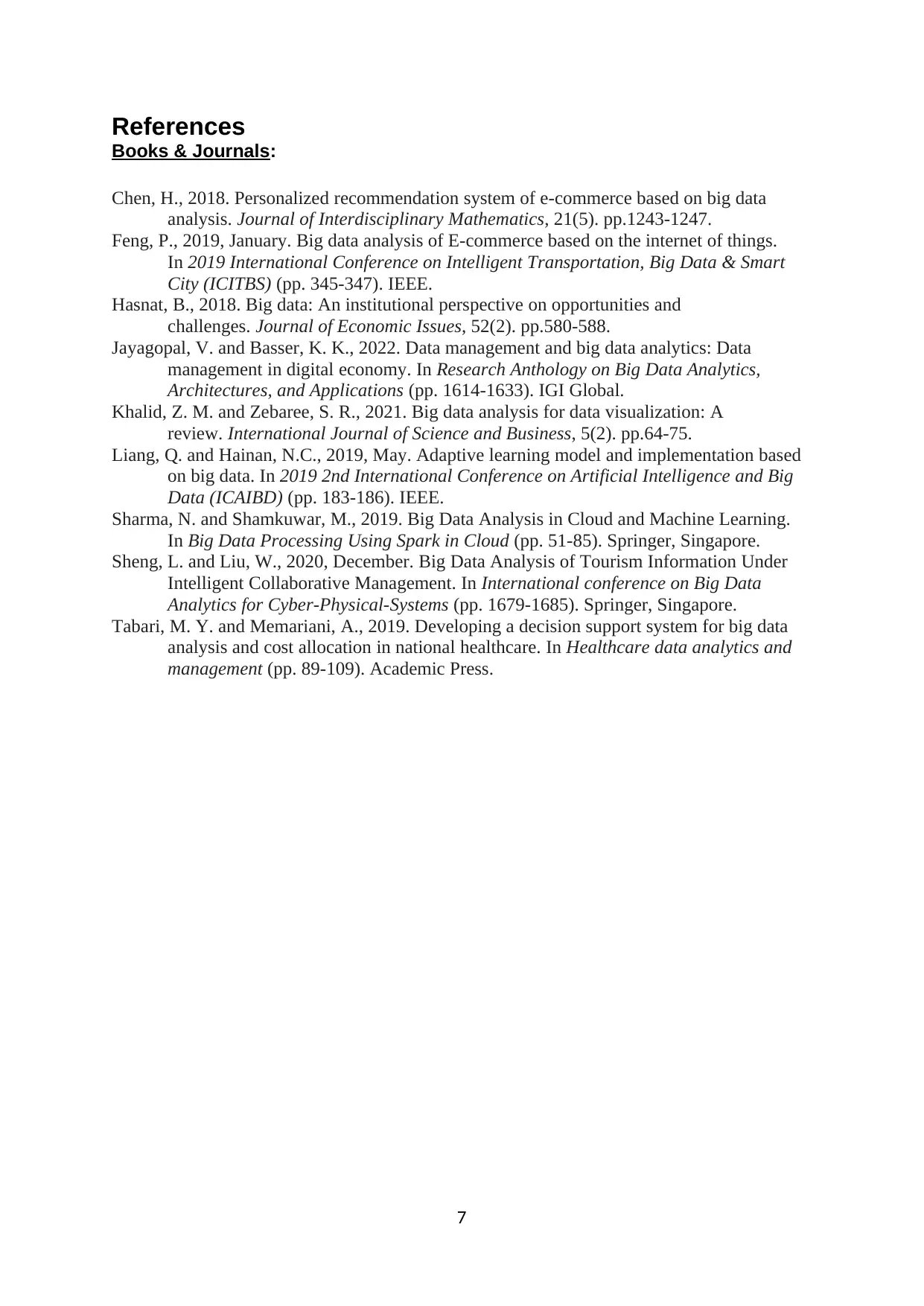
References
Books & Journals:
Chen, H., 2018. Personalized recommendation system of e-commerce based on big data
analysis. Journal of Interdisciplinary Mathematics, 21(5). pp.1243-1247.
Feng, P., 2019, January. Big data analysis of E-commerce based on the internet of things.
In 2019 International Conference on Intelligent Transportation, Big Data & Smart
City (ICITBS) (pp. 345-347). IEEE.
Hasnat, B., 2018. Big data: An institutional perspective on opportunities and
challenges. Journal of Economic Issues, 52(2). pp.580-588.
Jayagopal, V. and Basser, K. K., 2022. Data management and big data analytics: Data
management in digital economy. In Research Anthology on Big Data Analytics,
Architectures, and Applications (pp. 1614-1633). IGI Global.
Khalid, Z. M. and Zebaree, S. R., 2021. Big data analysis for data visualization: A
review. International Journal of Science and Business, 5(2). pp.64-75.
Liang, Q. and Hainan, N.C., 2019, May. Adaptive learning model and implementation based
on big data. In 2019 2nd International Conference on Artificial Intelligence and Big
Data (ICAIBD) (pp. 183-186). IEEE.
Sharma, N. and Shamkuwar, M., 2019. Big Data Analysis in Cloud and Machine Learning.
In Big Data Processing Using Spark in Cloud (pp. 51-85). Springer, Singapore.
Sheng, L. and Liu, W., 2020, December. Big Data Analysis of Tourism Information Under
Intelligent Collaborative Management. In International conference on Big Data
Analytics for Cyber-Physical-Systems (pp. 1679-1685). Springer, Singapore.
Tabari, M. Y. and Memariani, A., 2019. Developing a decision support system for big data
analysis and cost allocation in national healthcare. In Healthcare data analytics and
management (pp. 89-109). Academic Press.
7
Books & Journals:
Chen, H., 2018. Personalized recommendation system of e-commerce based on big data
analysis. Journal of Interdisciplinary Mathematics, 21(5). pp.1243-1247.
Feng, P., 2019, January. Big data analysis of E-commerce based on the internet of things.
In 2019 International Conference on Intelligent Transportation, Big Data & Smart
City (ICITBS) (pp. 345-347). IEEE.
Hasnat, B., 2018. Big data: An institutional perspective on opportunities and
challenges. Journal of Economic Issues, 52(2). pp.580-588.
Jayagopal, V. and Basser, K. K., 2022. Data management and big data analytics: Data
management in digital economy. In Research Anthology on Big Data Analytics,
Architectures, and Applications (pp. 1614-1633). IGI Global.
Khalid, Z. M. and Zebaree, S. R., 2021. Big data analysis for data visualization: A
review. International Journal of Science and Business, 5(2). pp.64-75.
Liang, Q. and Hainan, N.C., 2019, May. Adaptive learning model and implementation based
on big data. In 2019 2nd International Conference on Artificial Intelligence and Big
Data (ICAIBD) (pp. 183-186). IEEE.
Sharma, N. and Shamkuwar, M., 2019. Big Data Analysis in Cloud and Machine Learning.
In Big Data Processing Using Spark in Cloud (pp. 51-85). Springer, Singapore.
Sheng, L. and Liu, W., 2020, December. Big Data Analysis of Tourism Information Under
Intelligent Collaborative Management. In International conference on Big Data
Analytics for Cyber-Physical-Systems (pp. 1679-1685). Springer, Singapore.
Tabari, M. Y. and Memariani, A., 2019. Developing a decision support system for big data
analysis and cost allocation in national healthcare. In Healthcare data analytics and
management (pp. 89-109). Academic Press.
7
1 out of 8
Related Documents
Your All-in-One AI-Powered Toolkit for Academic Success.
+13062052269
info@desklib.com
Available 24*7 on WhatsApp / Email
![[object Object]](/_next/static/media/star-bottom.7253800d.svg)
Unlock your academic potential
© 2024 | Zucol Services PVT LTD | All rights reserved.


